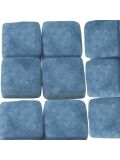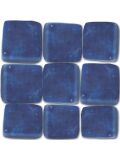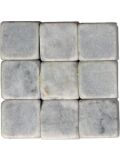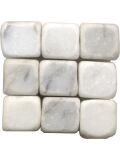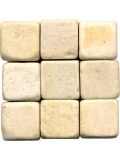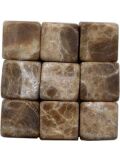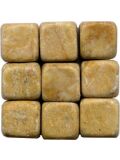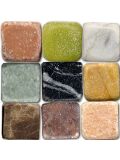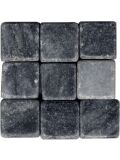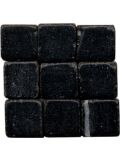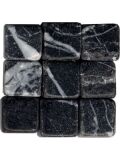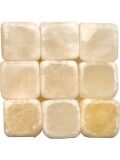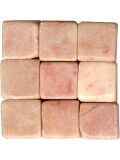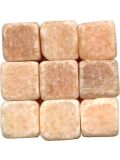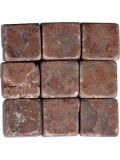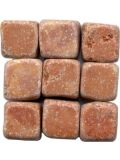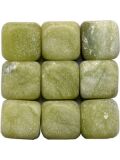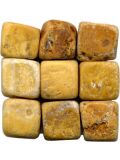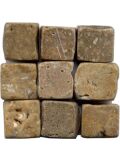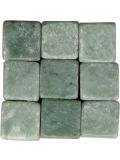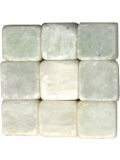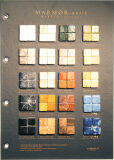Marble tiles 10x10mm
Marble Mosaic tiles
The small 1x1cm mini stone cubes are sold loose to be used for mosaic projects, wall decorations and as artistic mosaic works. Some stones are softer than other types (depending on the type of stone), and break differently. The harder the stone, the sharper the edges will be when broken. This even occurs with different batches of the same colour of stone, so it is an absolutely natural product. It is a natural material, extracted from different quarries, and that is exactly the reason and the character of the mosaic stone. No two are alike.
The small size of the stones allows for detailed mosaic images with little or no waste. This is important because cutting can affect the appearance of tumbled marble, as the tessera does not usually break as cleanly and predictably as ceramic or glass mosaic stones. All things considered, it is even possible to cut out pieces of stone with mosaic tongs or a mosaic hammer and shape them individually with a small file.
Many types of marble stones are not naturally marbled. Some stone colours, such as shades of blue, are artificially produced to provide colours that are difficult to obtain in nature. Nevertheless, all our marble mosaic stones are uncoloured natural stones with a natural appearance.
Product variations
Marble will vary slightly by batch for a number of reasons, but mainly because it is a natural material that can vary from quarry to quarry and even within the same quarry. Therefore, all stones will vary slightly in their stone colour and pattern.
What you should consider
It takes a tremendous amount of experience to cut stone tiles cleanly. In order to be able to offer marble stones at an affordable price, our manufacturers have to work very precisely and apply certain standards and quality controls. You should be aware that all types of tesserae can vary depending on the manufacturer's batch and therefore you should order your tesserae complete for each project and mix them before you start laying your project. Even the most expensive mosaic brands of Italian glass stones will advise you to check and mix different packs of their stones before using them.
Practice Tip
The thickness of the tiles is about 8mm, which is thicker than our normal glass mosaic tiles. If you press or indirectly lay tiles in thin-bed mortar or concrete, it is possible to use them with thinner glass tiles, but it would be problematic if you were to glue tiles to a flat surface because this would create different heights. When laying directly, always ensure the same height of 8mm if you want to use different types of stone such as glass, ceramic or marble.
Cutting marble
Our marble nipper H0185 is the recommended cutting tool for stone and other hard materials like porcelain. It is much easier to cut a tiny amount of stone than to try to cut a larger amount. Marble stone of 1x1cm, for example, is already great to cut in half and divide into pieces of 5x5mm. Of course, you can also work in the classic way with the mosaic hammer H0003 and the splitting wedge H0004. These tools allow you to divide the stones even more precisely, but require a little practice.
Grouting marble
Grouting unpolished and unsealed stones can discolour the mosaic stone because it is porous and can absorb the grout. The stone should be treated with a stone wax before grouting. Alternatively, the already discoloured mosaic stone can be cleaned again afterwards with a cement haze remover.
What we recommend to treat porous materials before grouting:
Glue your tesserae
Use a stone wax or sealer with a small paint brush. A dampened rag also works to seal just the top surfaces of the stones.
Be careful not to drip the sealer between the mosaic stones or the sides of the tiles.
The stone colours will actually improve / darken a little.
Marble mosaics outdoors
Most people think that stone is more durable than glass for outdoor mosaic art, but the opposite is true for several reasons.
A) Hardness
Not all stone is hard and natural stone only comes in a limited number of colours. To get the variety of colours that is often needed for a mosaic, additional types of stone are sometimes needed. This is especially true when we talk about affordable prices of stone. It is clear that emeralds have a great green, but they are also relatively rare, small and expensive.
B) Porosity and frost damage
Glass is not so porous and therefore water can penetrate the glass and freeze to expand, whereas porous stone cracks when frost penetrates. Remember that the reason why so many ancient Greek and Roman mosaics have survived after all these millennia is that the Mediterranean climate is relatively warm and dry. It also helped that many of the mosaics we have today have been buried under volcanic ash for centuries.
Marble is not as hard as you think, and it is also susceptible to chemicals. For example, the products of decaying organic matter like rotting leaves are too acidic. Marble also dissolves in acid. You can actually dissolve marble if you pour vinegar on it. For example, acid rain from automobile exhaust fumes in European cities has caused ancient statues to melt. So please take care beforehand where and how you lay your mosaics and protect the surface with a stone wax or stone sealant.
C) How to treat marble mosaics
Marble mosaics are best used indoors or in sheltered outdoor areas, such as a covered terrace, where water cannot collect on the surface. However, marble can be used outdoors if you protect it very well with a sealer and check the sealer every few years to make sure that water can still bead up on the surface instead of soaking in. It's really not a lot of work and can be done very quickly with a brush or rag. Even if you use non-porous glass tiles, you still need to seal the mosaic and check the seal regularly as the mortar between the tiles is porous and prone to frost damage. So outdoor marble mosaics on vertical surfaces such as walls and on horizontal surfaces such as benches or walkways can give you many years of enjoyment.
